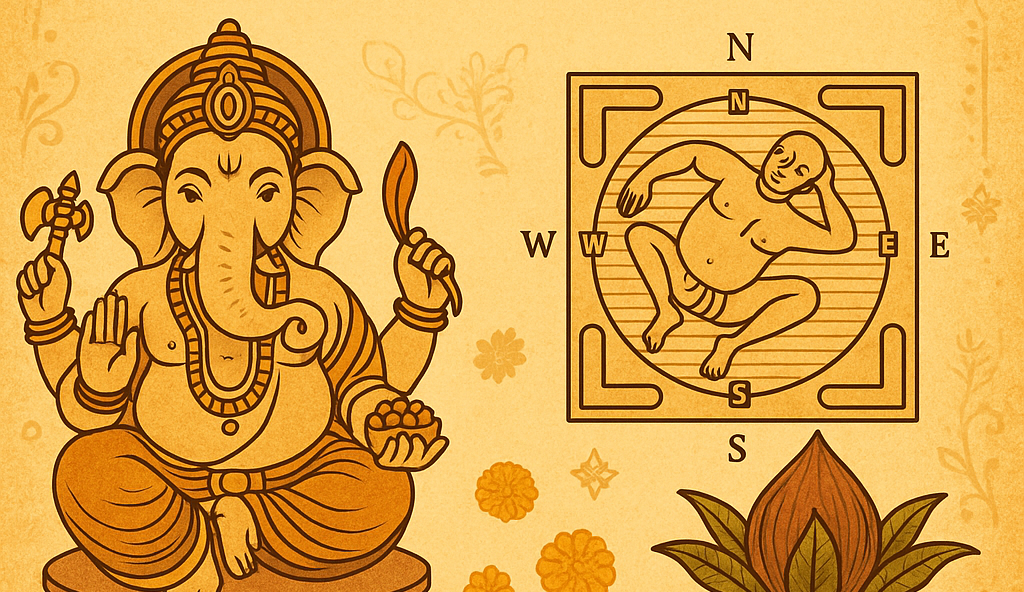
Vastu Shastra is an ancient Indian system that tells us how to design buildings and arrange spaces in a way that brings peace, health, and happiness. It’s not just a list of rules for making houses. It’s actually a deep and meaningful philosophy that shows how our lives are connected to the natural energies around us. To understand what Vastu really is, we need to look at where it came from, why it was created, and what it wants
to teach us.
Long ago, people lived very close to nature. They depended on sunlight, wind, land, and stars for survival. When they built shelters-like caves or huts-they didn’t use any plans. They just followed what felt right and safe. But slowly, as people got smarter, they began to notice certain things. For example, they saw that some directions got more sunlight, some places stayed cooler, and some house shapes felt more comfortable.
These experiences slowly became patterns. Over time, these patterns became rules, and these rules turned into a proper system. That’s how Vastu began. First, people shared this knowledge by word of mouth. Later, it was written down in holy books like the Vedas and Puranas. In the beginning, Vastu wasn’t a full science yet-it was more like a helpful guide based on personal experience.
But Vastu became a real science-a Shastra-when wise scholars and thinkers started to explain it using logic and natural laws. They gave reasons for why things should be placed in a certain way. This made Vastu something that could be studied, tested, and taught, just like modern science.
A major turning point came during the time of King Bhoj, a smart and kind ruler. He wasn’t just a king-he loved learning and culture. In his time, people combined Vastu with maths, stars, and measurements. He believed that building a house wasn’t just a job-it was a spiritual activity. The way a building was made could actually affect the energy and life of the people inside it. Thanks to King Bhoj, Vastu became a proper and respected field of study.
At the heart of Vastu is a very simple but powerful idea: everything in the world is energy, and this energy works best when there is order and balance. That’s why Vastu talks about the five elements or Panchtatva-Earth (Prithvi), Water (Jal), Fire (Agni), Air (Vayu), and Space (Akash). All living things, including humans, are made from these five elements.
Each element has its own power. For example, Earth gives strength and support, Water keeps things moving, Fire gives energy, Air helps us breathe and move, and Space connects everything together. These elements are not just outside in nature-they are inside our bodies too. When we build a house, it’s important that these five elements are placed correctly, or else the people living there might not feel well or happy.
To understand this better, think of how water is made: it takes two hydrogen atoms and one oxygen atom (H2O). If this mix is changed even a little, it becomes something else that might be harmful. In the same way, if fire is placed in the wrong corner of the house or water is placed in the wrong direction, it can create imbalance, leading to stress, illness, or money problems.
Many old civilizations knew about this balance, even if they didn’t call it Vastu. For example, the Indus Valley Civilization (like Mohenjo-Daro and Harappa) had well-planned cities with straight roads, proper drainage systems, and houses that allowed in sunlight and fresh air. These designs followed the same thinking as Vastu.
This tradition continued in India’s temples, which were built very carefully. A temple wasn’t just a place to pray-it was like a mini-universe, built to connect people with cosmic energy. The main god idol (called garbhagriha) was always placed in the center of the temple, known as the energy center (Brahmasthan). Every part of the temple-its halls, doors, and walls-was made to guide energy towards the people.
The idea behind this is that a building can affect your thoughts, emotions, and even your spiritual growth. This matches what modern scientists say today: how we feel depends a lot on the space we live or work in. That’s why concepts like green buildings, Feng Shui, and biophilic design are popular now-they are based on the same old truths that Vastu taught long ago.
Sadly, over time, people forgot this knowledge. Why? Because of foreign invasions, the destruction of old schools like Nalanda and Takshashila, and British rule which ignored Indian traditions. Slowly, Vastu was pushed into the background and remained only in old books and temples.
But now, people are interested in it again. Modern life has become fast, noisy, and stressful. So many people are going back to traditional ways to find peace and balance. Architects and home designers are once again learning and using Vastu-not just for looks, but to create spaces that actually feel good to live in.
In the end, Vastu Shastra teaches us that the places we live in are a part of us. If we build and design these places to match the natural flow of the Earth and the universe, then life becomes more peaceful and successful. So, Vastu is not just about construction-it is a life science that connects our homes to nature, energy, and the universe.
